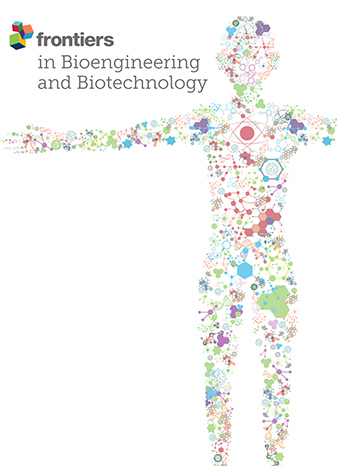Integrating conductive electrodes into hydrogel-based microfluidic chips for real-time monitoring of cell response
IF 4.3
3区 工程技术
Q1 BIOTECHNOLOGY & APPLIED MICROBIOLOGY
引用次数: 0
Abstract
The conventional real-time screening in organs-on-chips is limited to optical tracking of pre-tagged cells and biological agents. This work introduces an efficient biofabrication protocol to integrate tunable hydrogel electrodes into 3D bioprinted-on-chips. We established our method of fabricating cell-laden hydrogel-based microfluidic chips through digital light processing-based 3D bioprinting. Our conductive ink includes poly-(3,4-ethylene-dioxythiophene)-polystyrene sulfonate (PEDOT: PSS) microparticles doped in polyethylene glycol diacrylate (PEGDA). We optimized the manufacturing process of PEDOT: PSS microparticles characterized our conductive ink for different 3D bioprinting parameters, geometries, and materials conditions. While the literature is limited to 0.5% w/v for PEDOT: PSS microparticle concentration, we increased their concentration to 5% w/v with superior biological responses. We measured the conductivity in the 3–15 m/m for a range of 0.5%–5% w/v microparticles, and we showed the effectiveness of 3D-printed electrodes for predicting cell responses when encapsulated in gelatin-methacryloyl (GelMA). Interestingly, a higher cellular activity was observed in the case of 5% w/v microparticles compared to 0.5% w/v microparticles. Electrochemical impedance spectroscopy measurements indicated significant differences in cell densities and spheroid sizes embedded in GelMA microtissues.将导电电极集成到基于水凝胶的微流控芯片中,用于实时监测细胞反应
传统的片上器官实时筛选仅限于对预先标记的细胞和生物制剂进行光学跟踪。这项工作介绍了一种高效的生物制造方案,将可调水凝胶电极集成到三维生物打印芯片中。我们通过基于数字光处理的三维生物打印技术,建立了基于细胞的水凝胶微流控芯片的制造方法。我们的导电墨水包括掺杂在聚乙二醇二丙烯酸酯(PEGDA)中的聚(3,4-乙烯-二氧噻吩)-聚苯乙烯磺酸(PEDOT: PSS)微粒。我们优化了 PEDOT:PSS 微颗粒的制造工艺,并针对不同的三维生物打印参数、几何形状和材料条件对我们的导电墨水进行了表征。虽然文献中的 PEDOT: PSS 微颗粒浓度仅限于 0.5% w/v,但我们的导电墨水的浓度却达到了 0.5% w/v:PSS微颗粒浓度限制在0.5% w/v,而我们将其浓度提高到了5% w/v,并取得了优异的生物反应。我们测量了 0.5%-5% w/v 微颗粒浓度范围内 3-15 m/m 的电导率,并展示了三维打印电极在明胶-甲基丙烯酰(GelMA)包裹下预测细胞反应的有效性。有趣的是,与 0.5% w/v 微颗粒相比,5% w/v 微颗粒的细胞活性更高。电化学阻抗谱测量结果表明,嵌入 GelMA 微组织的细胞密度和球体大小存在显著差异。
本文章由计算机程序翻译,如有差异,请以英文原文为准。
求助全文
约1分钟内获得全文
求助全文
来源期刊

Frontiers in Bioengineering and Biotechnology
Chemical Engineering-Bioengineering
CiteScore
8.30
自引率
5.30%
发文量
2270
审稿时长
12 weeks
期刊介绍:
The translation of new discoveries in medicine to clinical routine has never been easy. During the second half of the last century, thanks to the progress in chemistry, biochemistry and pharmacology, we have seen the development and the application of a large number of drugs and devices aimed at the treatment of symptoms, blocking unwanted pathways and, in the case of infectious diseases, fighting the micro-organisms responsible. However, we are facing, today, a dramatic change in the therapeutic approach to pathologies and diseases. Indeed, the challenge of the present and the next decade is to fully restore the physiological status of the diseased organism and to completely regenerate tissue and organs when they are so seriously affected that treatments cannot be limited to the repression of symptoms or to the repair of damage. This is being made possible thanks to the major developments made in basic cell and molecular biology, including stem cell science, growth factor delivery, gene isolation and transfection, the advances in bioengineering and nanotechnology, including development of new biomaterials, biofabrication technologies and use of bioreactors, and the big improvements in diagnostic tools and imaging of cells, tissues and organs.
In today`s world, an enhancement of communication between multidisciplinary experts, together with the promotion of joint projects and close collaborations among scientists, engineers, industry people, regulatory agencies and physicians are absolute requirements for the success of any attempt to develop and clinically apply a new biological therapy or an innovative device involving the collective use of biomaterials, cells and/or bioactive molecules. “Frontiers in Bioengineering and Biotechnology” aspires to be a forum for all people involved in the process by bridging the gap too often existing between a discovery in the basic sciences and its clinical application.
文献相关原料
| 公司名称 | 产品信息 | 采购帮参考价格 |
|---|
 求助内容:
求助内容: 应助结果提醒方式:
应助结果提醒方式:


